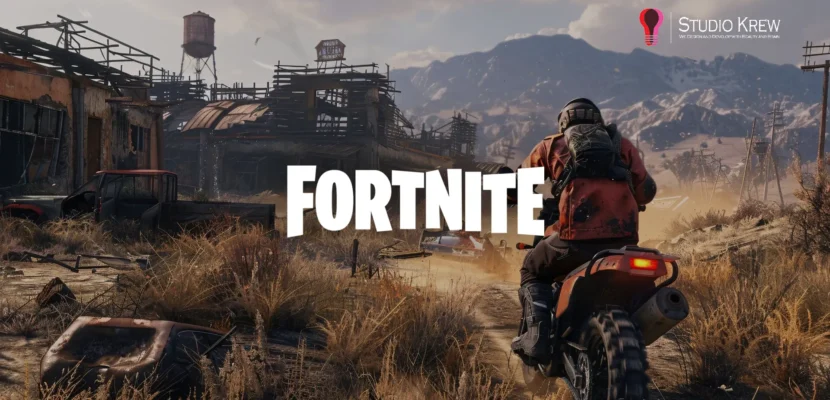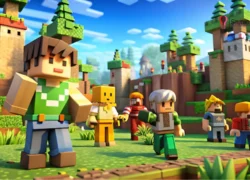Introduction – Fortnite: The Game That Changed It All
When Fortnite launched in 2017, most of us were expecting ‘just another shooter.’ What we got instead was a cultural wave that redefined the rules of engagement. As we fast forward to 2025, Fortnite stands as a testament to the potential of the gaming industry. It’s not just a game; it’s a constantly evolving platform, a cultural touchstone, and a billion-dollar business model that developers and studios continue to study and learn from.
But what made Fortnite different?
Was it the free-to-play model? The constant content updates? The mind-blowing in-game concerts and brand collaborations? The answer lies in the powerful fusion of game mechanics, monetization, cross-platform accessibility, and community engagement — all driven by top-tier execution and technology.
In this blog, we’ll break down:
- How much money does Fortnite make daily and yearly
- The technical innovations that power it
- The game design principles and monetization model that developers should adopt
- Why Fortnite is the ultimate blueprint for modern game development
- And how StudioKrew, a leading game development company, can help studios, startups, and brands build the next iconic gaming experience
Whether you’re an aspiring developer, a studio founder, or a brand exploring the gaming world, understanding why Fortnite works and how to learn from it could define your next big move in 2025.
Bonus: This blog is packed with real-world insights, lessons, and backlinks to practical services — so you’re not just reading theory, you’re discovering your next step in game innovation.
Fortnite Revenue in 2025: How Much Money Does Fortnite Make Daily and Annually?
It’s wild to think that Fortnite pulls in more in a single day than many indie games do in a year — all thanks to innovative design, not exploitative mechanics.
How Much Money Does Fortnite Make a Day?
Fortnite generates an estimated $1.2 million to $1.5 million per day in 2025. That’s not from upfront purchases or expensive subscriptions — it’s cosmetic, primarily microtransactions:
- Character skins
- Back bling accessories
- Unlockable gliders
- Dance emotes
- Seasonal Battle Passes
This ‘free-to-play’ yet cosmetic-driven model generates massive daily revenue without alienating casual players. It unlocks a global player base, turning monetization into an engagement incentive rather than a barrier to entry.
Fun fact: In just one day during the Travis Scott Astronomical Event, Fortnite pulled in over $20 million from in-game merchandise and digital sales.
How Much Money Does Fortnite Make a Year?
Fortnite has consistently remained a billion-dollar game year after year.
| Year | Estimated Revenue |
|---|---|
| 2018 | $5.4 Billion |
| 2019 | $3.7 Billion |
| 2020 | $5.1 Billion |
| 2023 | ~$5.8 Billion |
| 2025 | ~$6.1 Billion* (Projected) |
Even as competition increased and trends evolved, Fortnite’s LiveOps strategy, cultural collaborations, and event-based monetization kept players engaged and wallets open.
It’s not just about flashy graphics or combat mechanics — it’s about being a constantly evolving social and entertainment experience.
How Much Money Has Fortnite Made in Total?
By mid-2025, Fortnite is reportedly expected to have surpassed $25 billion in lifetime revenue, positioning it alongside some of the world’s most extensive entertainment franchises.
To put that into perspective:
- That’s more than what most AAA game series make in their lifetime
- More than the entire box office collection of franchises like Transformers or Fast & Furious
- And more than most game studios dream of in 20 years
This scale of revenue isn’t just a testament to Fortnite’s gameplay, but also its:
- Strategic monetization
- Global accessibility
- Developer agility in adapting and innovating
📌 Want to build your revenue-generating hit game? Explore AAA Game Development or partner with an Online Game Development Company like StudioKrew.
Also Read: What Is an AAA Game? Inside the World of Blockbuster Game Development
Fortnite’s Impact: Game-Changing Innovations
In a world where ambitious games abound, Fortnite didn’t just find success — it redefined it. Its disruptive design, monetization model, and, most importantly, its community-first philosophy, have altered the course of modern game development. For developers aiming to make their mark in 2025, understanding the impact of Fortnite isn’t just insightful — it’s essential. It’s about being part of a larger movement that values the player community above all else.
At StudioKrew, our team studies these shifts closely to create scalable, socially engaging, and high-retention experiences through full-cycle game development services. Here’s how Fortnite changed the game forever:
The Rise of Free-to-Play — Without Compromise
Before Fortnite, the term “free-to-play” was often associated with low-budget games or pay-to-win models. Fortnite flipped the narrative by offering a AAA-quality experience for free, making revenue not by forcing purchases, but by enticing users to express themselves through skins, dances, and emotes.
The result? A model where:
- Monetization doesn’t affect game balance
- Players want to pay for visual upgrades
- Seasonal Battle Passes introduce a “fear of missing out” that fuels engagement
This approach has inspired a generation of developers to focus on ethical monetization, a strategy we emphasize in our online game development and action game projects. It’s not just about making money; it’s about ensuring that players feel valued and respected, and that’s a future we can all look forward to in 2025.
Cross-Platform Play Became the Norm — Not the Exception
One of Fortnite’s most powerful innovations was its simultaneous cross-platform availability across PC, consoles, and mobile — all with synchronized accounts, inventories, and progression.
This move unlocked:
- Social connectivity across devices
- A broader player base and extended playtime
- Easier access for new players, regardless of hardware
At StudioKrew, we help studios build cross-device compatibility from day one, whether it’s mobile game development, PC game development, or next-gen console gaming experiences.
LiveOps as a Core Game Design Philosophy
Rather than building a static world, Fortnite built a living, breathing digital universe. This was made possible through a game design philosophy known as LiveOps. LiveOps is the practice of continuously updating and evolving a game, often in response to player feedback and behavior. From weekly map updates to surprise game modes and dramatic live events, Fortnite taught the industry that content must constantly evolve.
LiveOps enabled:
- Higher daily active user (DAU) retention
- Viral events like the “black hole” or in-game concerts
- Opportunities for real-time monetization
This type of responsive game design requires a tight feedback loop between development and analytics — something our full-cycle game development team is deeply experienced in delivering.
Collaborations Turned Into Blockbuster Events
Rather than simply inserting branded items, Fortnite built full-scale experiential crossovers that drove buzz, brand equity, and millions in in-game purchases.
Iconic examples include:
- Travis Scott’s Astronomical concert (45M+ viewers)
- Marvel’s Galactus event, complete with storyline integration
- Star Wars content drops with exclusive skins and emotes
These integrations didn’t just entertain — they turned Fortnite into a media and marketing platform, not just a game.
If you’re building a game with the potential to host real-world brands, influencers, or media events, StudioKrew’s AAA and FPS game development services are designed to scale your ideas beyond the screen.
Fortnite’s Tech Stack and Architecture: A Look Under the Hood
While Fortnite dazzled gamers with its vibrant graphics and thrilling gameplay, its true brilliance lies beneath the surface — in a tech stack so robust, scalable, and forward-thinking that it became the gold standard for live multiplayer experiences.
Whether you’re an indie developer dreaming big or a seasoned studio aiming for the next breakout hit, understanding Fortnite’s technology foundation can shape your roadmap. At StudioKrew, we specialize in bringing these sophisticated systems to life through full-cycle game development, tailored for performance, scale, and longevity.
Here’s what powers the billion-dollar beast behind the scenes:
Game Engine: Unreal Engine’s Next-Level Power
Fortnite runs on Unreal Engine, developed by Epic Games — the same studio behind Fortnite. Over time, the game transitioned to Unreal Engine 5, bringing state-of-the-art rendering, physics, and open-world capabilities.
- Nanite and Lumen technologies offer real-time lighting and high-fidelity assets
- Its modularity enables seamless porting to mobile, console, and PC
- UE5’s Blueprint visual scripting makes rapid prototyping easier
StudioKrew is a leading Unreal game development company that provides exclusive services for our AAA game development projects by selecting the appropriate engine based on platform requirements and genre complexity.
Multiplayer Architecture Built for Massive Concurrency
One of Fortnite’s technical masterpieces is its ability to host 100-player battle royale sessions across global data centers — without lag.
Key infrastructure pillars include:
- Dedicated servers with autoscaling using cloud platforms like AWS
- Real-time replication systems for bullet trajectories, physics, and player states
- Custom matchmaking queues for skill-based, region-based, or team-based grouping
- Client-side prediction to ensure smooth performance even on mid-tier hardware
StudioKrew’s multiplayer game development team builds similar systems using Photon Fusion, Mirror, and Unreal’s native networking stack to deliver real-time gameplay for mobile, console, and desktop platforms.
LiveOps Pipeline with Global CDN & Real-Time Updates
A defining trait of Fortnite is its ability to ship live updates without taking servers offline. Whether it’s new cosmetic content, map changes, or event-driven game modes, Epic delivers these through a dynamic LiveOps pipeline.
- Files are distributed via CDNs, ensuring global delivery with low latency
- Asset bundles are hot-swapped mid-session
- The DevOps team rolls out updates weekly with rollback support
This is only possible through a tightly integrated backend and real-time analytics system — both areas where our team at StudioKrew brings deep expertise as part of our Game LiveOps and Maintenance Services.
Game Security and Anti-Cheat Systems
With millions of dollars at stake daily, Fortnite has invested heavily in real-time cheat detection and fraud prevention:
- Encrypted packet transmission to prevent packet-sniffing
- AI-trained behavior monitoring to detect bots and hackers
- Hardware bans and software detection tools
- Server-side input validation for critical gameplay moments
When building competitive or massive multiplayer online games, we integrate robust cheat prevention and security tools to ensure fairness and stability at scale.
Analytics & Telemetry Integration
Fortnite’s decisions are heavily data-driven. Every jump, purchase, or rage quit is tracked to improve game balance and content planning.
- Heatmaps track where players die or disengage
- Telemetry tools log user behavior across sessions
- Event-based triggers adjust XP boosts, rewards, and engagement incentives
StudioKrew implements similar telemetry pipelines in all our mobile and PC game development projects, empowering game publishers to optimize player retention and monetization based on real data.
Takeaway for 2025 Developers
If you’re aiming to build a next-generation online multiplayer experience, Fortnite’s stack teaches one thing: Scalability isn’t a feature — it’s a foundation.
From seamless content delivery and cross-device synchronization to cheat-resistant architecture and adaptive matchmaking, your tech stack must be built for growth from the start.
Partnering with a studio like StudioKrew, which has proven success in delivering scalable, real-time multiplayer environments, gives your project the edge it needs to thrive in a market shaped by Fortnite.
Lessons for Game Developers in 2025 – What Fortnite Got Right
Fortnite wasn’t just a viral hit — it was a well-orchestrated masterclass in game development strategy. Every design decision, backend system, and monetization model offered a glimpse into what the future of gaming would look like.
For developers building in 2025, Fortnite delivers not only inspiration but a playbook of strategic lessons. At StudioKrew, we help our clients integrate these lessons into reality through tailored full-cycle game development, multiplayer system design, and AAA production pipelines.
Here’s what you should take away:
Design for Cross-Platform from Day One
Fortnite’s billion-dollar ecosystem proved that games must transcend devices.
- Players want flexibility — to start on console and continue on mobile
- Cross-play improves player retention and session length
- Social virality increases as friends on different platforms join the same session
At StudioKrew, we implement cross-platform support using Unity and Unreal Engine, optimized for mobile, PC, and console game development.
Make Multiplayer a Core Pillar
Multiplayer isn’t just a mode anymore — it’s a business model. Fortnite made real-time competition the heart of its retention engine.
Multiplayer gameplay:
- Increase session time
- Encourage repeat play and daily logins
- Promote user-generated content
- Foster competitive and social engagement
Our multiplayer game development team specializes in everything from real-time server architectures to skill-based matchmaking systems tailored for both casual and hardcore users.
Also Read: Which Game Engine is Better for Multiplayer Games? Unity vs Unreal
Integrate AI for Personalization and Retention
Fortnite’s matchmaking, adaptive difficulty, and gameplay suggestions were all enhanced by AI-powered systems. In 2025, AI is no longer optional — it’s the glue that binds retention.
StudioKrew offers AI-integrated game development services that include:
- Dynamic difficulty adjustment (DDA)
- Personalized in-game offers based on player behavior
- Predictive analytics for churn prevention
- AI bots to backfill multiplayer matches seamlessly
Monetize Ethically, But Effectively
Epic Games’ monetization strategy in Fortnite proved that players are willing to pay — if it feels fair. Cosmetics, season passes, and limited-time items generate urgency and income without creating imbalance.
Innovative monetization strategies include:
- Cosmetic stores with rotating items
- Subscription-based battle passes
- In-game currencies that can be earned or purchased
- Seasonal challenges that unlock tiered content
We help developers build similar systems in online games and action games that maximize lifetime value while maintaining community goodwill.
Think Beyond Launch: LiveOps Is the Real Game
The real game begins after the launch. Fortnite’s ability to constantly evolve has made it a sticky and culturally relevant phenomenon.
Successful LiveOps requires:
- A modular backend that supports updates without downtime
- A creative team continuously designing new events, seasons, and skins
- Real-time analytics and feedback loops
- Responsive dev teams to fix balance issues and exploits
StudioKrew’s full-cycle development approach ensures you’re not just building a game — you’re building an evolving product.
Build for Spectators, Not Just Players
Fortnite became a favorite on Twitch and YouTube because it was not only fun to play but also enjoyable to watch.
Spectator-friendly design elements:
- Streamer modes
- Exciting endgame mechanics
- Kill cams and replays
- High-contrast visuals and readable UIs
In 2025, building games with viral potential means designing them as experiences for both players and audiences — and that’s where StudioKrew’s UI/UX and gameplay animation teams shine.
Building a Fortnite-Style Game in 2025: What You Need to Know
Let’s move beyond gameplay mechanics and look at what truly sets Fortnite apart — its unforgettable in-game events.
But not without the right technology, vision, and development partner.
Fortnite didn’t succeed just because it was fun — it succeeded because it was engineered from the ground up to be scalable, modular, monetizable, and constantly evolving. In 2025, replicating that success means learning from it — and then engineering beyond it.
At StudioKrew, we help clients bring such ambitious ideas to life through our proven AAA game development services and full-cycle game development solutions.
Here’s what you’ll need:
1. A Multi-Platform Gameplay Strategy
To build a Fortnite-style experience, your game must run smoothly across PC, console, and mobile, and more importantly, it must feel native on each.
- Shared progression and accounts
- Real-time syncing between devices
- Optimized UI/UX for different screen sizes and input types
At StudioKrew, we develop cross-platform games using Unreal and Unity, ensuring consistent performance and gameplay across all devices from the first release.
2. A Scalable Multiplayer Backend
Fortnite’s Battle Royale mode supports 100+ concurrent players per session. Your architecture needs to handle:
- Lag-free real-time communication
- Skill-based or region-based matchmaking
- Server sharding and cloud autoscaling
- Latency optimization across geographies
Our multiplayer game development team uses Photon Fusion, Mirror, PlayFab, and custom socket-based networking to deliver smooth gameplay at scale, whether it’s a 1v1 duel or a 100-player survival match.
3. A Robust Monetization Engine
Revenue is the engine of sustainability. Fortnite built a system where players pay happily, not out of pressure, but because they want to.
You’ll need:
- Timed cosmetic item stores
- Season-based battle pass systems
- Dual-currency conversion models
- Personalized offers, bundles, and offer walls
StudioKrew designs monetization systems that are player-friendly and revenue-driven, drawing from experience in online game development and real-money game design principles.
4. A LiveOps-Ready Development Workflow
Games like Fortnite never stop. Neither should your dev pipeline.
To support dynamic content updates, your workflow needs:
- A modular asset system
- Event triggers that update without app restarts
- A backend dashboard for deploying limited-time modes, skins, and UI changes
- Continuous integration and rollout systems
This is where StudioKrew’s LiveOps infrastructure plays a critical role — helping our partners scale updates without disrupting gameplay or losing players.
5, A Strong Creative & UI/UX Team
Fortnite’s look, feel, and “hype” factor all stem from brilliant creative work:
- Stylized 3D characters
- Vibrant environments
- Fluid emotes and animations
- Responsive HUDs and intuitive control mapping
From concept to final render, our internal team of game designers, UI/UX experts, and 2D/3D artists creates iconic game worlds that sell themselves.
6. A Clear Timeline and Budget Plan
So, how long does it take to build a Fortnite-scale game?
- MVP (Minimum Viable Product): 6–9 months
- Alpha Launch: 12–14 months
- Beta + LiveOps rollout: 18–24 months
- Full Global Launch: 2+ years
The cost? It depends on the scale, platform count, and art fidelity — but with StudioKrew, we ensure you get a high ROI by making strategic tech and feature choices early.
Can StudioKrew Help You Build the Next Fortnite?
Yes — we’re already helping several studios and publishers build their next-generation multiplayer hits. Whether it’s a stylized mobile shooter, a real-money survival game, or a full-scale battle royale on consoles, our teams have the expertise, tech stack, and processes to deliver at AAA-level quality.
So, if your ambition is not just to make a game but launch a phenomenon, StudioKrew is your go-to game development partner.
In-Game Event Highlights – Fortnite’s Marketing Genius
One of the most underappreciated innovations of Fortnite lies not in its gameplay mechanics, but in its ability to turn live in-game events into global pop culture moments. These weren’t just cool features. They were carefully engineered, immersive marketing strategies that earned Fortnite millions of dollars, millions of new users, and billions of impressions.
Let’s take a look at how Epic Games turned marketing into gameplay — and how these strategies can inspire your own game’s success in 2025.
The Travis Scott Astronomical Concert
In April 2020, Fortnite hosted a virtual concert by rapper Travis Scott that redefined digital events. The stage morphed around players, a giant Scott avatar performed, and the experience was fully interactive.
- 45.8 million live viewers across five showings
- Over $20 million in revenue from branded in-game items
- First-of-its-kind press coverage on gaming, music, and culture platforms
This event didn’t just showcase musical creativity — it proved that in-game experiences could rival physical ones in engagement and profitability.
At StudioKrew, we help clients design immersive, scripted multiplayer events using custom multiplayer development pipelines and scalable backend tools, allowing for synchronized sequences across global sessions.
Galactus – The Marvel Finale Event
Fortnite’s Season 4 Marvel crossover culminated in a real-time battle with Galactus, one of Marvel’s most powerful villains.
- Integrated lore from both the Fortnite and Marvel universes
- Real-time player participation in the defense effort
- Watched live by 15.3 million players, streamed by millions more
This event blurred the line between gameplay and cinematic storytelling, demonstrating how IP integration can become a core experience rather than a secondary promotion.
StudioKrew’s AAA game development team can help build these cinematic moments inside your gameplay engine using custom tools, Unreal Engine scripting, and immersive UI storytelling.
The Star Wars: Rise of Skywalker Tie-In
Imagine unlocking a lightsaber in real-time, just minutes after seeing an exclusive Star Wars clip in-game. Fortnite made that a reality.
- Hosted exclusive trailer premieres inside the game
- Dropped Star Wars weapons and cosmetics immediately after
- Bridged Hollywood and gaming in a way no studio had before
This moment illustrated that games could become a marketing platform for global IPs, rather than merely riding on their coattails.
If you’re building a game with branded content or influencer integrations, StudioKrew supports IP onboarding, licensing-safe environments, and LiveOps-driven marketing modules in our online game development solutions.
Why These Events Matter in 2025
These moments weren’t accidental — they were the result of carefully planned systems. And that’s precisely what StudioKrew builds into every next-gen title. They:
- Increased daily active users (DAU)
- Drove returning player spikes
- Created shareable, streamable, and viral content
- Generated direct revenue from themed cosmetics
For your next game, integrating event architecture and real-time activations should be a core part of your roadmap, not an afterthought.
At StudioKrew, we develop systems that allow you to design and schedule in-game events, challenges, and real-world collaborations through modular LiveOps frameworks and scalable multiplayer architectures.
StudioKrew’s Role in Building Next-Gen Games
Fortnite’s legacy is not just about mechanics and monetization — it’s about building an ecosystem that lives, evolves, and scales.
At StudioKrew, we understand that creating the next Fortnite isn’t about copying its formula — it’s about adapting its principles to fit your unique vision. With a decade-long track record in building scalable, cross-platform, and multiplayer-first games, we’re trusted by brands and startups alike to deliver standout gaming experiences in 2025 and beyond.

If you’ve got the ambition, we’ve got the roadmap. Here’s what working with us looks like:
End-to-End Game Development, From Concept to Launch and Beyond
As a leading full-cycle game development company, StudioKrew offers comprehensive services that guide you through every stage of development:
- Pre-production: ideation, game design documents (GDD), wireframes
- Production: coding, art creation, level design, multiplayer implementation
- Post-launch: LiveOps, updates, analytics, and scaling
Whether you’re targeting mobile, PC, or console platforms, we deliver games that are technically sound and commercially ready.
Scalable Multiplayer Infrastructure for Real-Time Engagement
Inspired by Fortnite’s massive player sessions? Our multiplayer game development services are designed for optimal performance and stability worldwide.
We architect:
- Lag-free matchmaking and server-side logic
- Photon, Unreal Engine, and custom socket solutions
- Real-time PvP, co-op, and Battle Royale gameplay
- Cross-platform sync with persistent player data
For larger scopes, such as 100+ player environments or MMO-style gameplay, our massive multiplayer game development solutions ensure seamless scalability.
Integrated Monetization Systems that Drive ROI
Much like Fortnite, we build monetization models that respect the player experience while delivering real revenue.
Our monetization modules include:
- Cosmetic stores and time-limited bundles
- Season pass frameworks
- In-game economy with soft and premium currencies
- Behavioral triggers for personalized offers
This is especially critical in our online game development projects, where daily engagement loops and spend incentives are seamlessly embedded into the core gameplay.
LiveOps-Ready Architecture for Dynamic Content Delivery
The reason Fortnite stayed relevant? Constant content updates and unforgettable events.
At StudioKrew, we build systems that support:
- Weekly content drops
- In-game event triggers
- Backend admin panels for real-time control
- Player segmentation and A/B testing for events
This makes us the ideal partner if you’re planning to run your game as a live service, whether you need holiday campaigns, tournaments, influencer integrations, or story-based chapters.
AAA Quality, Built by an Agile & Creative Team
Visual excellence is no longer optional — it’s expected. Our AAA game development team seamlessly integrates art, UI/UX, and animation to create a cohesive and immersive experience.
We deliver:
- 2D/3D concept and production art
- Stylized and hyper-real character design
- Modular environments for scalable level design
- Optimized assets for mobile, console, and PC
Our creative workflows ensure that your game looks and feels like a blockbuster, regardless of the platform on which it’s running.
A Development Partner You Can Trust
With 700+ global gaming projects delivered and a strong foundation in agile methodology, StudioKrew is more than a vendor — we’re your strategic partner.
We bring:
- Transparent milestones and sprint-based delivery
- Post-launch support and scaling
- Regular QA, playtesting, and optimization cycles
- IP-protected development and brand collaboration support
Whether you’re building a real-money multiplayer game, an entertainment-first Battle Royale, or a hybrid gamified app, we bring Fortnite-grade thinking to your vision, with grounded, proven execution.
Final Thoughts – Fortnite’s Legacy and the Future of Game Development
Fortnite didn’t just set records — it set standards.
It taught the world that a game could be a cultural movement, a live event stage, a monetization powerhouse, and a cross-platform phenomenon — all at once. Its success reshaped the industry’s expectations for game design, community engagement, and revenue generation.
For developers in 2025, Fortnite is more than a reference point. It’s a roadmap. One that emphasizes:
- Continuous innovation through LiveOps
- Scalable multiplayer infrastructure
- Fair yet profitable monetization
- AI-driven personalization
- Spectator-ready game design
We’ve worked with studios that started with nothing more than a bold idea — and now have games live in 30+ countries. It all starts with thinking beyond just launch day.
As a global game development company, we specialize in turning bold visions into real, scalable, engaging games — the kind that not only succeed in the market but define it.
So if you’re reading this and thinking ‘we could do this too’ — you’re probably right. Let’s talk.
👉 Let’s make your vision legendary — partner with StudioKrew today.





